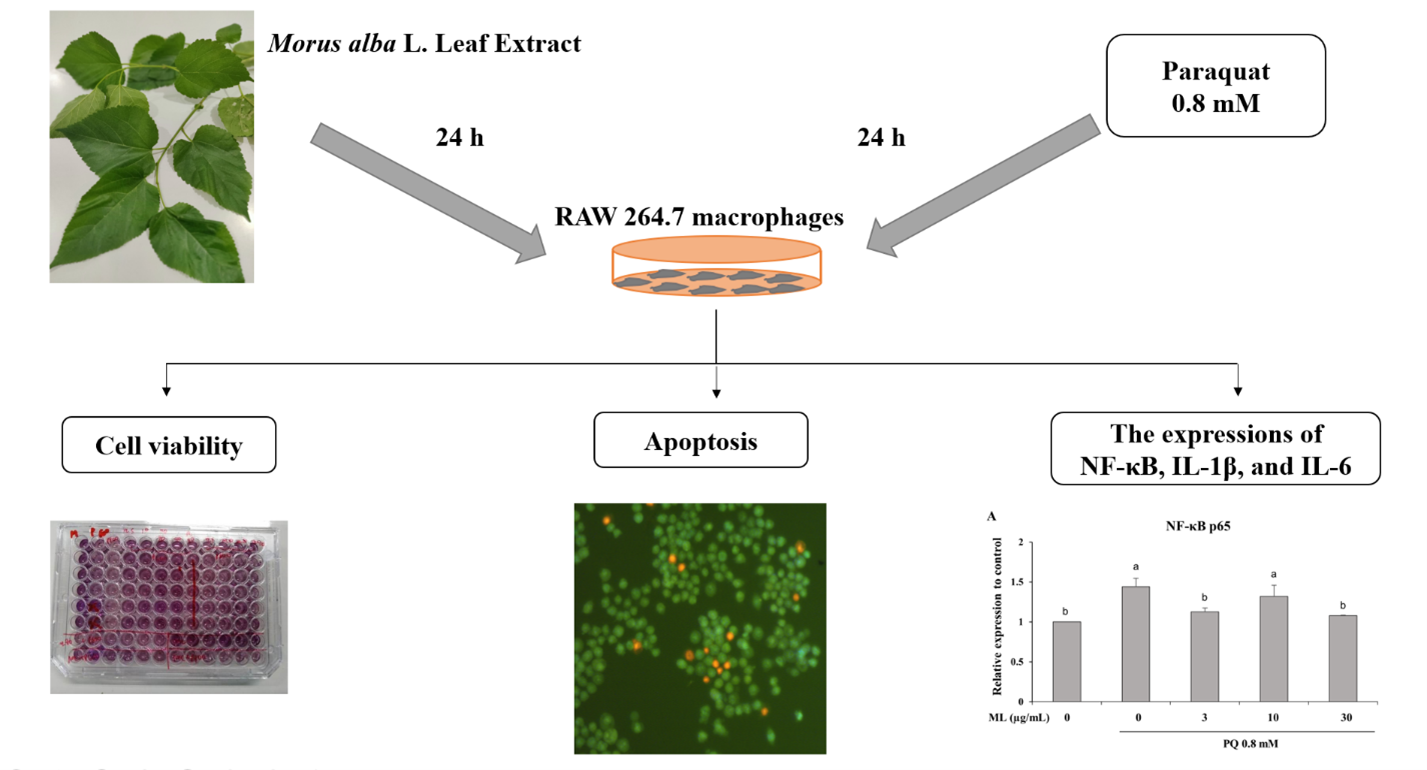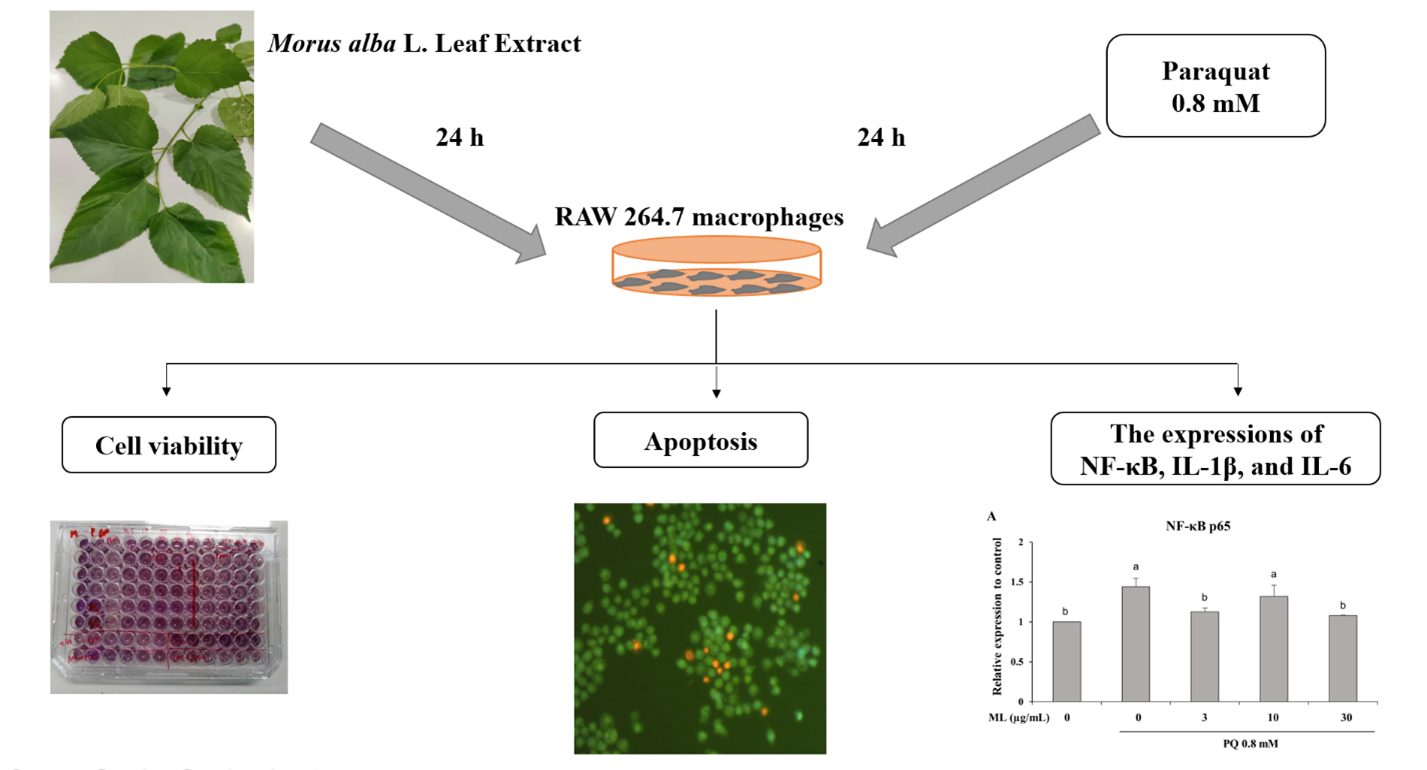Morus alba L. Leaf Extract Exerts Anti-Inflammatory Effect on Paraquat-Exposed Macrophages
DOI:
https://doi.org/10.48048/tis.2023.6206Keywords:
Paraquat, Morus alba L. leaf extract, RAW 264.7 macrophages, NF-κB, IL-1β, IL-6Abstract
Paraquat (PQ) is a widely used herbicide in agricultural areas. However, it has been reported to cause harm to animals or humans exposed to this herbicide. Generally, PQ stimulates the production of reactive oxygen species within cells causing cell death and resulting in bodily abnormalities. At present, efforts are being made to find drugs to reduce the toxic effects of PQ and natural products are targets of interest. This study aimed to assess the effect of mulberry (Morus alba L.) leaf extract on macrophages (RAW 264.7) after exposure to PQ, including the viability and expressions of NF-κB, IL-1β, and IL-6. We treated RAW 264.7 macrophages with Morus alba L. leaf extract in the absence or presence of PQ. Subsequently, viability, apoptosis, and expressions of NF-κB, IL-1β, and IL-6 were examined. It was found that the extract of mulberry leaves could inhibit apoptosis, increase viability, and significantly downregulates expressions of NF-κB, IL-1β, and IL-6 when RAW 264.7 macrophages were exposed to PQ. These phenomena indicated that Morus alba L. leaf extract has properties to reduce the inflammatory effect caused by the herbicide PQ.
HIGHLIGHTS
- Morus alba L. leaf extract improved the PQ-induced apoptosis of RAW 264.7 macrophage
- Morus alba L. leaf extract inhibited the expression of NF-κB, IL-1β, and IL-6 of RAW 264.7 macrophages
GRAPHICAL ABSTRACT
Downloads
Metrics
References
J Chen, Y Su, F Lin, M Iqbal, K Mehmood, H Zhang and D Shi. Effect of paraquat on cytotoxicity involved in oxidative stress and inflammatory reaction: A review of mechanisms and ecological implications. Ecotoxicol. Environ. Saf. 2021; 224, 112711.
T Wen-Tien. A review on environmental exposure and health risks of herbicide paraquat. Toxicol. Environ. Chem. 2013; 95, 197-206.
Z Liu, X Wang, Y Wang and M Zhao. NLRP3 inflammasome activation regulated by NF-kappaB and DAPK contributed to paraquat-induced acute kidney injury. Immunol. Res. 2017; 65, 687-98.
Q Wu, Q Xu, X Jian, H Wang, X He, B Gao, K Wang and B Kan. A new sight for paraquat poisoning from immunology. Immunopharmacol. Immunotoxicol. 2018; 40, 269-72.
Y Shao, Y Zhao, T Zhu, F Zhang, X Chang, Y Zhang and Z Zhou. Paraquat preferentially induces apoptosis of late stage effector lymphocyte and impairs memory immune response in mice. Int. J. Environ. Res. Publ. Health 2019; 11, 2060.
X Wang, F Luo and H Zhao. Paraquat-induced reactive oxygen species inhibit neutrophil apoptosis via a p38 MAPK/NF-kappaB-IL-6/TNF-alpha positive-feedback circuit. PLos One 2014; 9, e93837.
S Yadav, N Nair, A Biharee, V Morris Prathap and J Majeed. Updated ethnobotanical notes, phytochemistry and phytopharmacology of plants belonging to the genus Morus (Family: Moraceae). Phytomed. Plus. 2022; 2, 100120.
C Chen, UHM Razali, FH Saikim, A Mahyudin and NQIM Noor. Morus alba L. plant: Bioactive compounds and potential as a functional food ingredient. Foods 2021; 10, 689.
S Iqbal, U Younas, Sirajuddin, KW Chan, RA Sarfraz and K Uddin. Proximate composition and antioxidant potential of leaves from three varieties of Mulberry (Morus sp.): A comparative study. Int J. Mol. Sci. 2012; 13, 6651-64.
E Park, SM Lee, JE Lee and JH Kim. Anti-inflammatory activity of mulberry leaf extract through inhibition of NF-κB. J. Funct. Foods 2013; 5, 178-86.
K Liu, PC Liu, R Liu and X Wu. Dual AO/EB staining to detect apoptosis in osteosarcoma cells compared with flow cytometry. Med. Sci. Monit. Basic Res. 2015; 21, 15-20.
Z Wu, I Nagano, K Asano and Y Takahashi. Infection of non-encapsulated species of Trichinella ameliorates experimental autoimmune encephalomyelitis involving suppression of Th17 and Th1 response. Parasitol. Res. 2010; 107, 1173-88.
S Kalaiselvan and MK Rasool. Triphala herbal extract suppresses inflammatory responses in LPS-stimulated RAW 264.7 macrophages and adjuvant-induced arthritic rats via inhibition of NF-κB pathway. J. Immunotoxicol. 2016; 13, 509-25.
P Srinontong, J Wandee and W Aengwanich. Paraquat modulates immunological function in bone marrow-derived macrophages. Acta Vet. Hung. 2022; 70, 64-72.
X Chang, W Lu, T Dou, X Wang, D Lou, X Sun and Z Zhou. Paraquat inhibits cell viability via enhanced oxidative stress and apoptosis in human neural progenitor cells. Chem. Biol. Interact. 2013; 206, 248-55.
P Suthamwong, M Minami, T Okada, N Shiwaku, M Uesugi, M Yokode and K Kamei. Administration of mulberry leaves maintains pancreatic β-cell mass in obese/type 2 diabetes mellitus mouse model. BMC Compl. Med. Ther. 2020; 20, 136.
HW Liang, TY Yang, CS Teng, YJ Lee, MH Yu, HJ Lee, LS Hsu and CJ Wang. Mulberry leaves extract ameliorates alcohol-induced liver damages through reduction of acetaldehyde toxicity and inhibition of apoptosis caused by oxidative stress signals. Int. J. Med. Sci. 2021; 18, 53-64.
Y Sriset, W Putalun and W Chatuphonprasert. Effects of extract of Morus alba Linn. callus and mulberroside A on glutathione profiles in paracetamol-induced oxidative stress mouse livers. Isan J. Pharmaceut. Sci. 2016; 12, 49-60.
S Arumugam, RA Thandavarayan, PT Veeraveedu, M Ma, VV Giridharan, W Arozal, FR Sari, V Sukumaran, A Lakshmanan, V Soetikno, K Suzuki, M Kodama and K Watanabe. Modulation of endoplasmic reticulum stress and cardiomyocyte apoptosis by mulberry leaf diet in experimental autoimmune myocarditis rats. J. Clin. Biochem. Nutr. 2012; 50, 139-44.
T Liu, L Zhang, D Joo and SC Sun. NF-κB signaling in inflammation. Signal Transduct. Targeted Ther. 2017; 2, 17023.
Y Shibata, N Kume, H Arai, K Hayashida, A Inui-Hayashida, M Minami, E Mukai, M Toyohara, A Harauma, T Murayama, T Kita, S Hara, K Kamei and M Yokode. Mulberry leaf aqueous fractions inhibit TNF-α-induced nuclear factor κB (NF-κB) activation and lectin-like oxidized LDL receptor-1 (LOX-1) expression in vascular endothelial cells. Atherosclerosis 2017; 193, 20-7.
CH Chang, YT Chang, TH Tseng and CJ Wang. Mulberry leaf extract inhibit hepatocellular carcinoma cell proliferation via depressing IL-6 and TNF-α derived from adipocyte. J. Food Drug Anal. 2018; 26, 1024-32.
F Ma, W Shen, X Zhang, M Li, Y Wang, Y Zou, Y Li and H Wang. Anti-HSV activity of Kuwanon X from mulberry leaves with genes expression inhibitory and HSV-1 induced NF-κB deactivated properties. Biol. Pharmaceut. Bull. 2016; 39, 1667-74.

Downloads
Published
How to Cite
Issue
Section
License
Copyright (c) 2022 Walailak University

This work is licensed under a Creative Commons Attribution-NonCommercial-NoDerivatives 4.0 International License.






